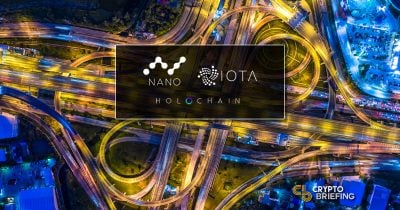Blockchain Beware: DAG And Block Lattice Are Here

Share this article
How often has the average cryptocurrency investor heard “blockchain, not bitcoin” ramble across their feeds? Or now, “bitcoin, not blockchain?”
Often cryptocurrency is heavily associated with blockchain, but there are other protocols and platforms in the broader realm of decentralized and distributed technology.
Some examples of alternative cryptocurrency infrastructure include Directed Acyclic graphs (DAG), distributed hash tables (DHT), and block lattice, among others.
In this article, we discuss three cryptocurrency projects that do not use blockchain as their core protocol:Nano, Iota, and Holochain. These projects explore scalability, data storage, consensus among nodes, and improving transaction processes.
Nano
Nano rebranded from its original namesake RaiBlocks in January of 2018. The payments-focused cryptocurrency offers no fees, near-instant transactions, and extremely high scalability. To date, Nano claims its network has processed over 14 million transactions with an unpruned ledger of 7.5 GB.
Behind the cryptocurrency is a DAG block lattice architecture, which provides each account with its own blockchain (account-chain) that can only be modified by the account owner. Through this model, a consensus is achieved by a balance-weighted vote on conflicting transactions. The more weight attached to a transaction, the more likely it is to receive approval from consensus nodes.
As each user maintains their account-chain in the block lattice structure, consensus among all the chains is met by delegated proof of stake (dPoS) voting to agree on a shared global state of the ledger.
Advantages to the Nano cryptocurrency include quick and fee-less transactions, a lightweight protocol, and minimal hardware requirements for nodes (as most transactions only require nodes to record and rebroadcast blocks).
But there are also some disadvantages, such as that block confirmations are stored off-chain. With zero fees, some critics claim that there are not enough incentives to run an honest node; with enough delegates, bad actors can acquire large amounts of NANO and carry a voting attack for financial gain or network demise.
Nano tokens were pre-mined with a maximum supply of 133,248,290 NANO and distributed through a captcha-based faucet distribution system that ended in October 2017.
IOTA
IOTA is cryptocurrency designed for the Internet of Things (IoT), with features that will be required to establish a machine-to-machine micropayment system. In theory, the more transactions that occur on the IOTA network the more significant decrease in confirmation times.
Unlike the blockchain, IOTA utilizes a Tangle, which in which each transaction references two previous transactions and stores them on the DAG. When a new transaction occurs, it must approve two previous transactions on the ledger, so users must work to approve other activity on the network.
Consensus is met by following the heaviest Tangle, which takes place as transactions receive more and more approvals. The more approvals a transaction has, the more accepted it is by the system due to higher confidence.
The advantages for IOTA are quick transactions with zero fees, resistance to quantum computing attacks, and high scalability.
Its disadvantages include the fact the Tangle does not currently support smart contracts, and it currently has a centralized network coordinator (that programmers plan to phase out sooner rather than later).
As IOTA was designed for many micropayments between devices on a network, it has a total of 2,779,530,283,277,761 premined tokens, or 2.8 million GIOTA (Gi).
Holochain
This newcomer is a next-generation distributed network, designed around distributed cloud-based IT infrastructure. Holochain aims to compete with entities like Dropbox, by using nodes to offer processing power to dApps on the utility platform.
The project represents a shift from a data-centric blockchain model to an agent-centric model that claims to offer a scalable solution to distributed computing platforms. Whereas data-centric models focus on creating a “single shared data reality among all nodes,” Holochain, according to its white paper, aims to allow nodes to “share independent evolving data realities.”
As opposed to tracking the entire ledger of all user transactions, Holochain host nodes will only monitor their own transactions. Host nodes will communicate their transactions across distributed hash tables (DHT) where every node “enforces validation rules on that data in the DHT as well as providing provenance of data from the source chains where it originated.”
Holochain’s advantages include data integrity maintenance without the need for consensus, prompt and efficient processing, immediate and efficient processing, and it doesn’t use proof of work or proof of stake consensus models.
The project’s disadvantages are that its capacity has yet to be put to the test with real-world use cases; the Mainnet is not yet live, and developing dApps on the platform places more responsibility on developers.
Currently, there are 177,619,433,541 ERC-20 Holochain tokens (HOT) that will convert to Holofuel when the Mainnet launches. Holofuel will be used to compensate node hosts for sharing their computing power.
The author is currently invested in Bitcoin.
Share this article
